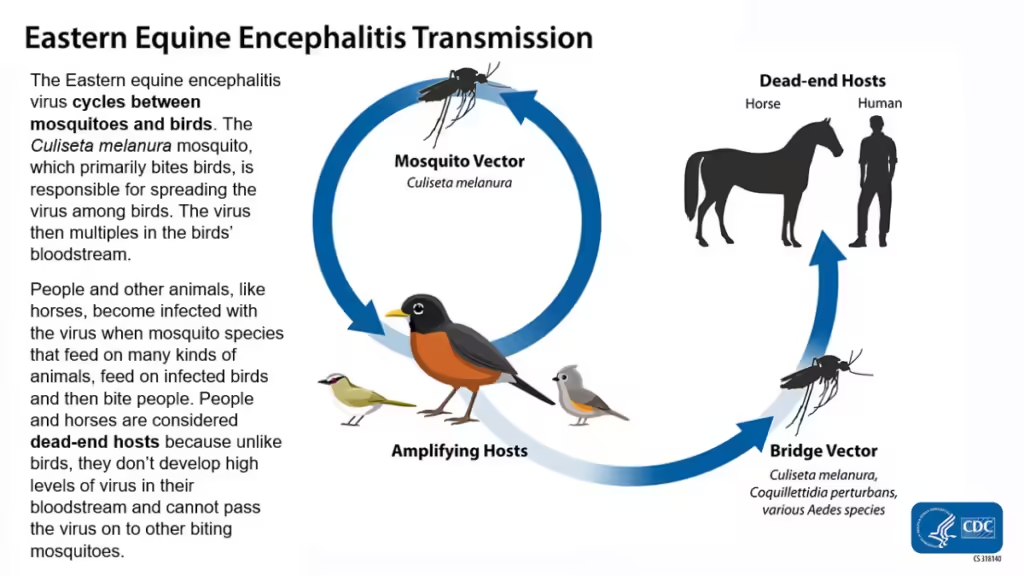eastern equine encephalitis eee virus: The Eastern Equine Encephalitis (EEE) virus is a rare but serious mosquito-borne illness that can lead to severe brain inflammation in humans, horses, and other animals. Originating from the Togaviridae family, the EEE virus is primarily transmitted by mosquitoes, particularly those of the Culiseta melanura species.

Despite its name, the disease is not exclusive to horses; humans are also at risk, especially during the warmer months when mosquito activity is at its peak.
How is the Eastern Equine Encephalitis (EEE) Virus Spread?
The EEE virus is typically spread through the bite of an infected mosquito. Mosquitoes become carriers of the virus after feeding on infected birds, which serve as the primary hosts. While the virus circulates naturally among bird populations, it can be transmitted to mammals, including humans and horses, when bitten by an infected mosquito.
The risk of contracting the Eastern Equine Encephalitis (EEE) virus is highest in areas with wetlands or swamps, where mosquito populations thrive. The eastern and Gulf Coast regions of the United States, as well as the Great Lakes area, are particularly vulnerable to outbreaks.
Symptoms of Eastern Equine Encephalitis (EEE) Virus Infection
Symptoms of EEE virus infection can range from mild to severe. In many cases, individuals infected with the virus remain asymptomatic. However, those who do develop symptoms may experience fever, headache, chills, and vomiting, which can progress to severe neurological conditions like disorientation, seizures, and coma.
Severe cases of Eastern Equine Encephalitis (EEE) virus infection can lead to encephalitis, or inflammation of the brain, which may result in permanent neurological damage or death.
The mortality rate for those who develop EEE is approximately 30%, making it one of the deadliest mosquito-borne diseases in the U.S.
Prevention and Treatment
Currently, there is no specific antiviral treatment for the Eastern Equine Encephalitis (EEE) virus. The best approach is prevention. Public health officials recommend reducing exposure to mosquitoes through various protective measures:
- Use Insect Repellent: Apply EPA-approved insect repellent containing DEET, picaridin, or oil of lemon eucalyptus.
- Wear Protective Clothing: Long sleeves, pants, and socks can reduce the risk of mosquito bites.
- Avoid Peak Mosquito Hours: Mosquitoes are most active from dusk to dawn, so limiting outdoor activities during these times can reduce exposure.
- Eliminate Standing Water: Mosquitoes breed in stagnant water. Removing sources of standing water around your home can reduce mosquito populations.
Vaccines are available for horses, but there is no vaccine for humans at this time.
Current Status and Risks
Eastern Equine Encephalitis (EEE) virus remains a rare disease in humans, with only a few cases reported each year in the United States. However, due to its high fatality rate and the severity of its symptoms, it is considered a significant public health concern, particularly in regions where the virus is known to circulate.
Public health officials closely monitor mosquito populations and the presence of the EEE virus in birds and horses to predict potential outbreaks. Residents in areas prone to Eastern Equine Encephalitis (EEE) virus outbreaks are encouraged to stay informed about local mosquito control efforts and any public health advisories regarding the virus.
Conclusion
While Eastern Equine Encephalitis (EEE) virus is rare, its potential to cause severe and fatal illness makes it a serious concern. Taking proactive steps to prevent mosquito bites and staying informed about local health advisories can significantly reduce the risk of infection.
